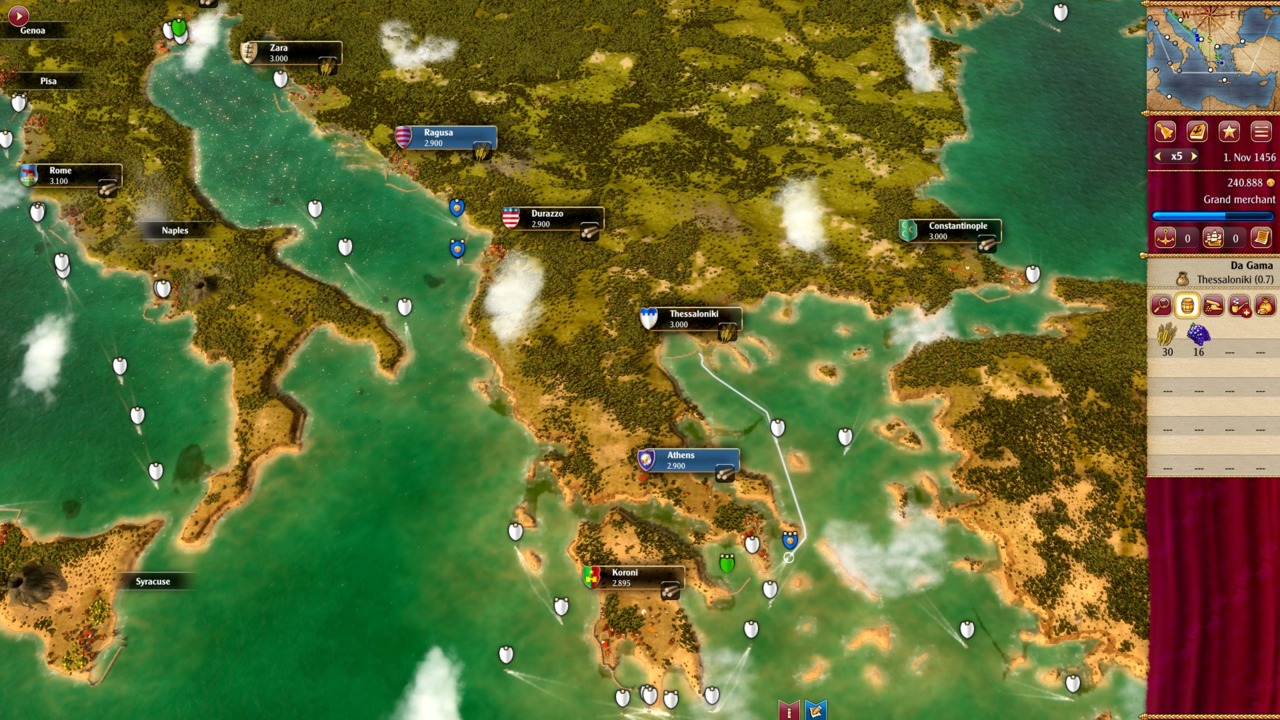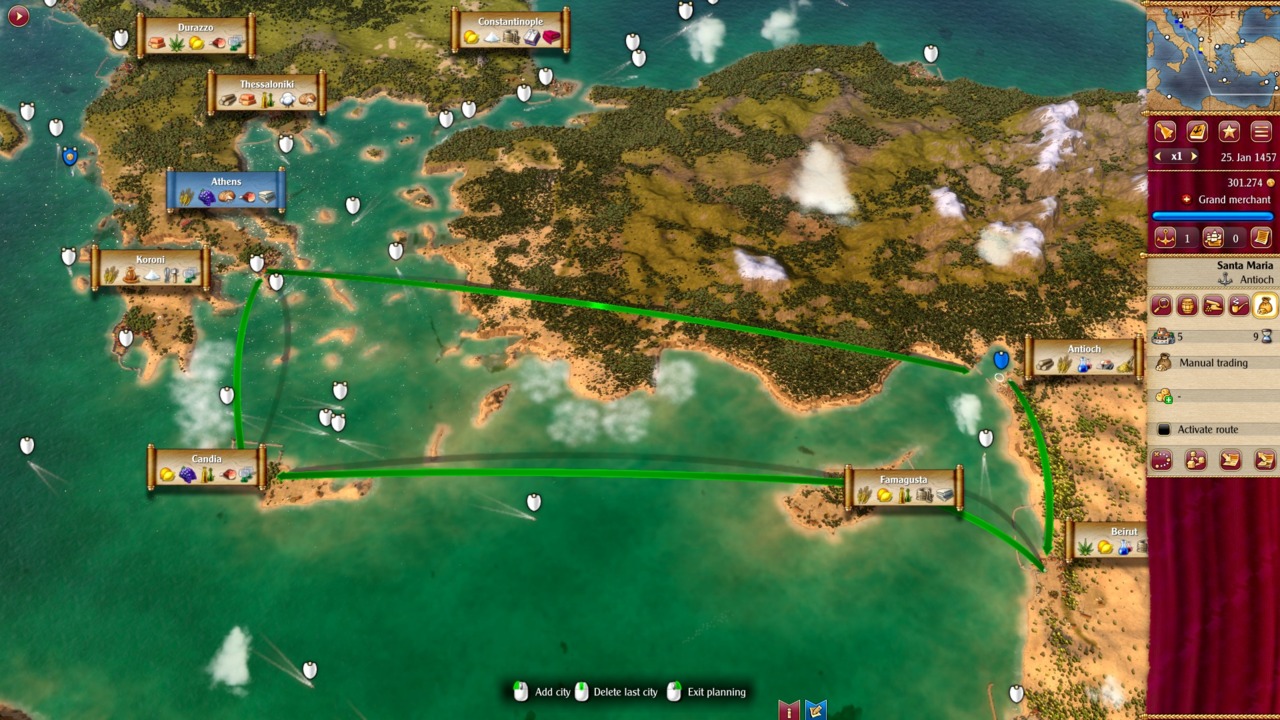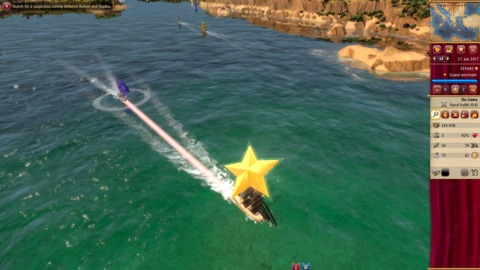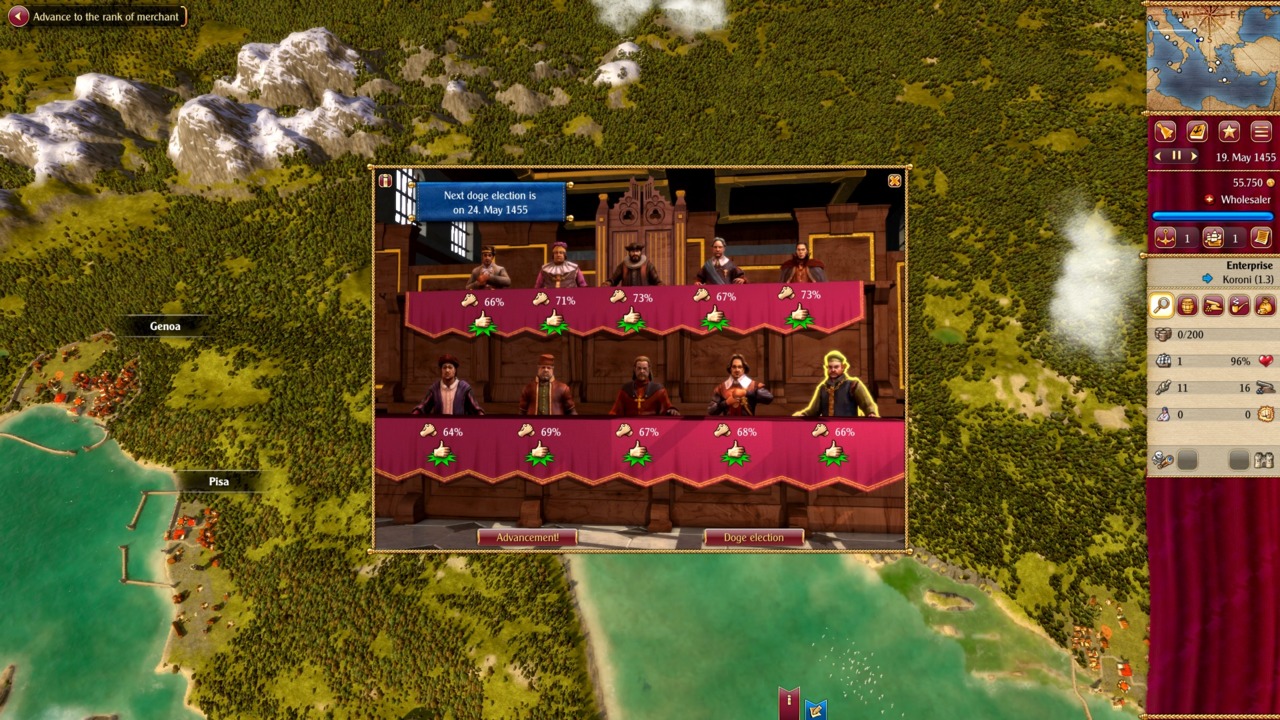Whether I'm lining up on Black Friday or I'm scrounging through the stalls at a flea market, I have no problem putting in the hard work needed to get a good deal. But Rise of Venice pushed me a little farther than I would have liked. While this trading simulation about life as a 15th-century Venetian trader has loads of appeal when exploiting the base need that we all have to shop smartly, it is much more demanding than hanging out in a shopping center parking lot all night hoping to snag a cut-rate TV. Paltry in-game help and manual documentation make it tough to come to grips with the trading system in the early hours of play, which in turn makes it tough to appreciate the good things the game has to offer on the downward slope of its learning curve. This is a game that demands a lot up front but pays off down the road as long as you stay patient when it comes to online homework and in-game experimentation.
Rise of Venice follows in the wake of developer Gaming Minds' earlier trading efforts Port Royale 3 and Patrician IV. In the single-player campaign, you take on the role of a Venetian merchant in the mid-15th century. At the beginning of the game, the elder scion of your trading family finally shuffles off this mortal coil, leaving you a vessel and a dream of schlepping wood, grapes, honey, and other goods from one port to another in about two dozen cities spread around the Mediterranean Sea. If you want to hit the waves without any story in the cargo hold, you can go for the sandbox-style free play or the more mission-oriented scoreboard match where you are presented with set victory goals like earning a certain rank, setting up a specific number of businesses, or making a set amount of cash. Online and local multiplayer free play and scoreboard games are also offered, although good luck finding a match on the servers, which might as well have the digital equivalent of tumbleweed blowing through them.

The basic conceit is just as you would expect. Your goal is to buy low and sell high. Making a profit is a snap while you are manually conducting all trade. There are easy runs up and down the Italian boot, moving fruit and pottery and the like for big bucks. Even later on, after things get more complex, the markets offer a lot of room for you to make serious money. Different regions have different specialties, so you can roam around shipping exotic goods like spices from the Levant cities back to the west, move wine from the south to the north, and so forth. The only complication early on is paying for trading licenses in neutral or allied cities, or bribing your way into the ranks of rivals in the employ of Venice's chief enemy, Genoa.
Things get trickier fast, though. After you commission a few convoys and are pressed to earn serious coin to continue progressing up the social ladder in Venice (money and things like stowage and the number of sailors under hire are used to calculate your rank, which is voted on in the senate back home), it's impossible to do manual trading. So you need to set up trade routes that automatically buy and sell goods in specific ports of call. This is not easy, at least in the beginning. While the campaign walks you through some trading mechanics, it reveals nearly nothing about the intricacies of automating trade routes. The manual is just as obtuse, with little space dedicated to trade routes, even though they form the heart of the game. I needed to trudge through forums at both Steam and publisher Kalypso for advice on how to set up trade routes, and then experiment within the game to get them working effectively.
It's a shame that Rise of Venice is hard to warm up to initially, because there is a lot to like when you get beyond the early frustrations of establishing trade routes.
It took some serious messing around with trading before I figured it out. I spent a lot of time playing with the series of sliders and buttons that govern every item individually, setting various buy and sell margins and then watching the routes in action to see if they were profitable or not. Once I got the hang of this, however, it was simple to set up routes with buy and sell margins that let me rake in seemingly unlimited amounts of cash.
Still, it shouldn't be so difficult to get to this point. You should be able to simply click a couple of buttons to tell your trade convoy captains to, for example, automatically sail between Venice and its neighbors Ragusa, Zara, and Durazzo buying low and selling high when it comes to all of the goods that the cities have on hand. The initial hurdles will undoubtedly turn people off through sheer frustration, and it's completely unnecessary. Based on the forum posts, I'm not the only dummy out there who initially had trouble with this key aspect of the game. A more detailed tutorial reviewing how the whole trading system works would be a huge help.

It's a shame that Rise of Venice is hard to warm up to initially, because there is a lot to like when you get beyond the early frustrations of establishing trade routes. The game includes an interesting political layer. Rivals in Venice try to sabotage just about everything you do. They spread rumors that get you blocked out of ports, slam your reputation, steal from your warehouses, and do just about anything else underhanded that they can think of to prevent your trading business from making money. Of course, you can pull the same dirty tricks, as long as you have the cash to hire the operatives needed to spread smears or rob enemies. You can also take on missions to curry the favor of council members.
The game even features a nifty mechanism that makes you play politics, because you can't progress through the ranks without winning votes in the senate. Fail to trash foes and grease palms, and you stall in gaining the levels needed to run the large numbers of convoys and access all of the goods that are traded (the 22 items in the game, ranging from raw materials to finished goods like clothing and glass, are unlocked as you progress in rank). The only drawback is that you can make money so readily through trade routes that you can simply bribe your way to winning council votes without fooling around with the dirty deeds noted above. It's not as satisfying, but it's easier to dish out cash than it is to take on missions or pay operatives to attempt reputation-damaging stunts that may or may not be successful.

More than trading is offered. Cities are built up with warehouses that expedite trade routes; various production facilities that let you produce items like salt, oils, and fruit; and homes for your workers. Big trading money comes after you start producing items for sale on your own, rather than relying on third parties. Cities offer regular missions during the campaign. These assignments generally involve moving more goods--although some jobs deal with combat and various go-fetch tasks--but they do add focus to your duties alongside the freewheeling trading. You also get random duties that advance storylines, such as working with spies and developing ongoing intrigue with the rival Genoans. Some of these duties can be drawn out and dull, though. There are too many irritating combat missions and even a treasure hunt early on that sees you pixel hunting around the map for tiny buoys marking the locations of scraps of a treasure map.
Speaking of combat, it's a hazard that needs to be dealt with while building your maritime empire. Unfortunately, it's the least thought-out aspect of the game design. Sea battles are chaotic and stupid, with ships essentially spinning around in circles firing cannons until one side or the other eventually sinks. Speed is another problem, since ships move more like Jet Skis than stately Renaissance brigs. You can barely think during battles, let alone strategize. Scraps can be simmed, but the campaign forces you to fight manually on a regular basis. You have to board enemy vessels and at times take on one enemy convoy after another in mind-numbing battles. The only plus to combat is how the very threat of it forces you to strategize. Knowing that you could be attacked by pirates at any time makes you prepare by configuring convoys with escorts, stocking cannons to sink bad guys, and adding extra sailors armed with cutlasses and pistols to deal with boarding parties.
Rise of Venice is a looker, especially for what amounts to a spreadsheet on the high seas. There is a lot of atmosphere here, largely due to rolling waves that gleam with reflected sunlight. Everything looks more postcard-like than you would expect out of a Mediterranean setting, though, with all of the sunshiny visuals making you feel like you're in the Caribbean. The cheerful setting makes the whole game more welcoming. Cities are also realistically busy, with people running all about (even if the scale is more akin to villages than the real bustling burgs of Renaissance Europe). The game is also easier to navigate than predecessors Port Royale 3 and Patrician IV. Everything takes place on the same main map screen now. To get up close and personal with a city, all you need to do is zoom in close instead of switching to a different view. This speeds up the tempo and gives the game more of an organic feel, with just about everything at your fingertips. If not for the overly complicated automated trading system, the interface would be ideal.

Audio effects further accentuate the nautical setting. Crashing waves surround you at all times. Bells ring whenever you sail into a port. Seagulls cry off in the distance. Incredible width spreads sounds all around you, giving the impression that the cranky noise of those seagulls might be coming from the next room and not the speaker on your desktop. Music is just as striking, mainly due to the forlorn notes that it hits. There isn't anything specifically nautical about the soundtrack, although the lonely horns and echoing drums evoke the somewhat depressing majesty of a life at sea.
Stay the course, and you will get a lot out of Rise of Venice. That doesn't excuse the bad first impression provided by the confusing trade routes, but this is one of those games where patient players reap rewards. Keep at it, and you might just learn a few things about making a deal for yourself when Black Friday next rolls around. OK, you won't. But you will learn something about how to sell exotic spices in the 15th-century Mediterranean, which might be a little more intriguing than queuing up for another cheapie television.